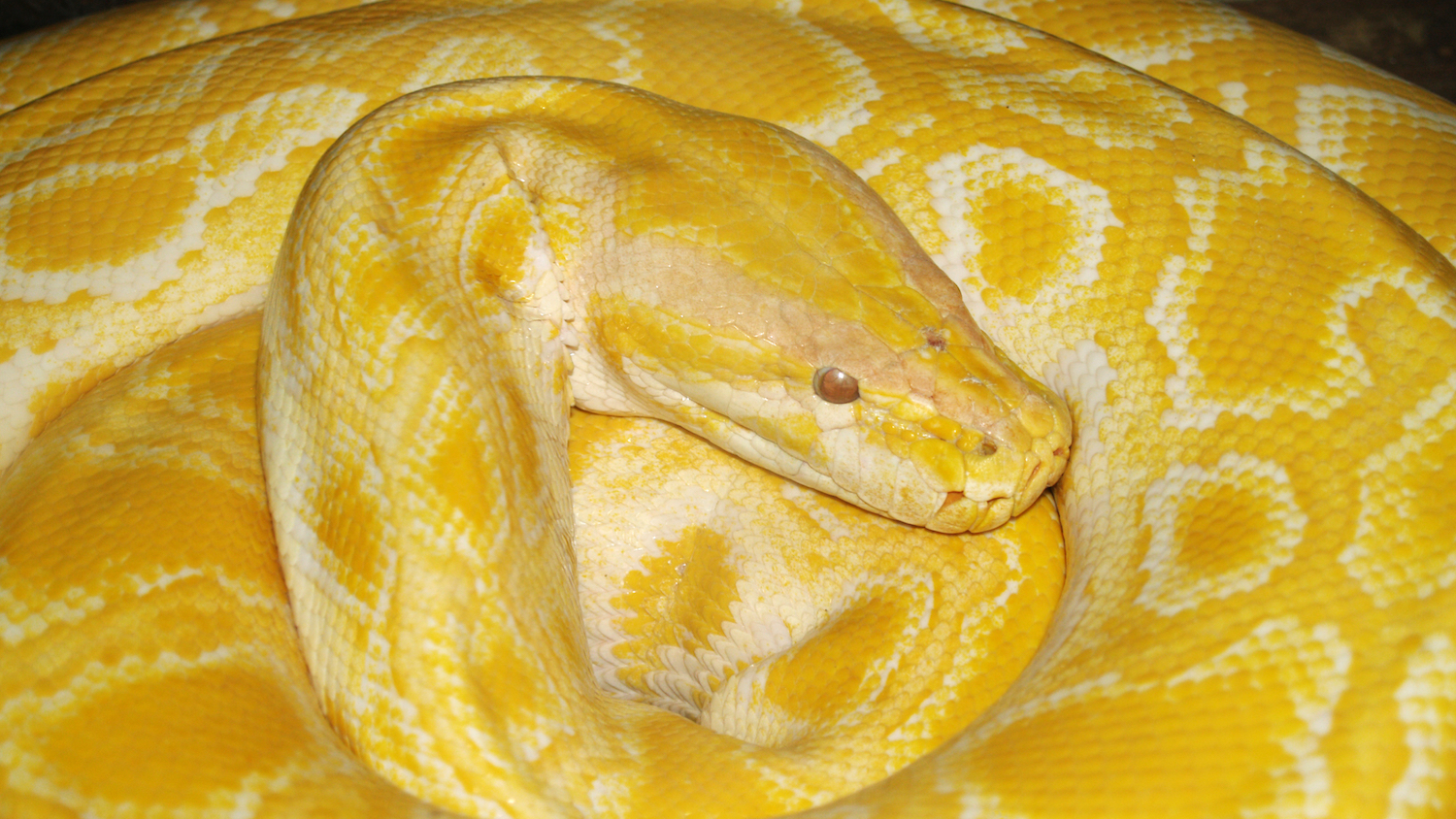Burmese Python in Ice?
I ran the Charm City Reptile and Amphibian Rescue for 14 years (no longer in operation). Here is a story about one of the rescues, a Burmese python.
The call
One winter day, I received a call from someone who worked for Baltimore County. It was a cool day, but luckily, it was above freezing.
These workers, who were on their way back to their office from a job working on a road, saw an odd sight. It was a large yellow and white snake on the side of the road. It wasn’t moving much and appeared to have some blood on its face. The blood was either coming from its nose or mouth or possibly from a scrape.
It appeared to the workers to be covered in ice, which was even more strange.
The man on the phone said that he didn’t really have any type of container in their truck. So they put the animal in a pair of chest waders, bright yellow plastic-y coveralls, and kind of tied it up to keep the snake inside. They knotted each pant leg and somehow tied up the top part. It was so cold that the snake wasn’t moving much anyway. One guy kept his eye on the snake and the other guy was driving. They were nervous and excited about it.
They showed up about a half hour later with a pair of bulging hip waders.
I was almost afraid to look into the waders because of the fact that the animal had ice on it. Ice and tropical snakes do not go well together!
I noticed pieces of shed skin falling out of the waders. I peeked inside to see a filthy, scraped-up, bruised albino Burmese python with a serious respiratory infection. The “ice” was actually shedding skin and not ice at all. That was a plus. I checked the outside temperature and it was 43° F, not freezing. This temperature is not at all appropriate for a Burmese python that is native to tropical Asian weather. They don’t hibernate. Where they come from, it never gets cold enough.
In cold weather, they simply die.
Diagnosis
I was sure this animal had just been released. The facial injuries were superficial. But the respiratory infection was very serious. Burmese pythons are notorious for getting respiratory infections when they are not kept warm enough. This snake was a male, about 9-10 ft. long. It had bubbles coming from its nose, a sure sign of an upper respiratory infection. It was breathing from the mouth and not from the nostrils a lot of the time. There was a gooey, snotty discharge coming from his mouth and nose, wiped on the side of the cage I set up.
He went on injectable antibiotics – which is fun to do by yourself on a large snake – for a few weeks. The first injection is easy. The animal doesn’t know what to expect and is generally so sick that it does nothing. The second injection, the animal does know what to expect and maybe is also feeling a tiny bit better. We were using Baytril, which is a broad-spectrum antibiotic made by Bayer (not used in humans) that stings and often leaves a scar. By the third injection, it gets pretty difficult. You have to get a good angle to get the injection intra-muscularly, and you want to put the needle between the scales and not pierce the scales. I’ll just say, it quickly becomes a two-person job.
By the time the snake shed again, it was looking a lot better. The deep red bruising, which was easy to see due to the snake’s white and yellow coloration, was slowly disappearing.
Burmese python facts
Burmese pythons are not easy animals to place. We generally have at least one at any given time. We’ve had as many as four at one time, although not all that large. They can grow to about 18 feet in length and weigh about 150 pounds. That’s not an animal that just anyone can keep. Recently there has been legislation to try and remove this species completely from the pet trade. They can be amazing and gorgeous pets. People just need to be prepared for the expense and space these snakes require.
We try to screen all of our adopters carefully, but I take even more precautions with the larger animals.
I like to make sure that the snakes are eating frozen-thawed prey before I place them. All of our animals are fed frozen-thawed whenever possible for the well-being of everyone. Especially with large animals, the prey is large and can injure the reptile. Big rats have big teeth. Large snakes that are used to eating frozen-thawed prey items instead of live ones seem to be a little more mellow.
Boas and pythons have heat pits (holes in their faces) and can sense temperature. This helps them find warm blooded prey animals in the wild.
Usually, once you get past the feeding response, Burmese pythons are very good-natured and curious snakes. A feeding response occurs when you reach into a cage. For about the first 30 seconds, the animal reacts on instinct to seeing movement (and sensing heat) in the cage. When you feed pre-killed or frozen-thawed prey, the snakes don’t recognize it as food. Using tongs, people often shake the prey to get the snake’s attention.
Staying safe
When you are dealing with an animal that can seriously hurt or kill someone, every precaution should be taken. I don’t handle any snakes over 10 ft. by myself. If they need to be medicated, I make arrangements to be sure I don’t have to medicate them by myself. Even if the person doesn’t physically help me (if they are not a reptile person), they can still just make sure everything is okay. As long as someone is able to dial 911, I feel safer! Any snake that can hurt you should be kept in a cage with a lock. Keeping cages locked will ensure the safety of everyone in the family, including cats, dogs or other pets.
Some people use hooks and some use shields when dealing with large snakes. I have both. I use whatever is handy. My friend Mike made me a nice, clear plexiglass shield with a handle. If the snake strikes, it will hit the shield and not me. Once, a large boa struck it so hard the shield cracked, but that’s another story.
Eventually, the albino Burmese stopped wheezing. Just heating it up, helped a great deal. The antibiotics got rid of the respiratory infection. The Burmese python was adopted after several months with hardly any evidence of the injuries.
Please leave your comments below.
Read more by Holli Friedland.


Holli, Your animal stories are so interesting and enlightening. I love reading them.